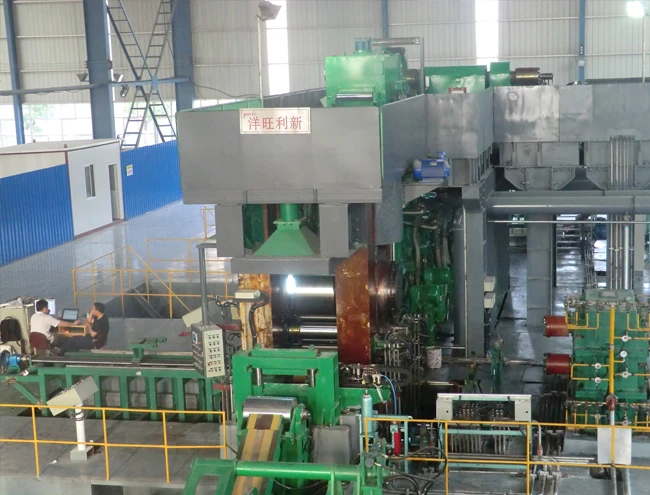
Understand hot rolling and cold rolling production lines
Iron and steel industry is the foundation of modern industry, and rolling technology is an important link to transform steel from raw materials into various steel products. In the process of steel rolling, hot rolling and cold rolling are the two most common processing methods. Although they belong to the same rolling process, there are significant differences in production line layout, process flow, product performance and application fields. This paper will deeply discuss the characteristics and application of hot rolling and cold rolling production lines.
Hot rolling production line
The basic principle of hot rolling
Hot rolling refers to the process of rolling billet into required size and shape at high temperature. Usually, after the billet is heated to a high temperature of 1100 C ~ 1250 C, it is gradually thinned and elongated by a rolling mill until it reaches the required specifications.
Layout of hot rolling production line
The hot rolling production line mainly includes the following procedures:
Heating furnace: billet first enters the heating furnace and is heated to a temperature suitable for rolling by burning fuel.
Roughing mill set: the heated billet is initially formed by roughing mill set, usually reducing the cross-sectional area and lengthening the billet.
Intermediate transportation: between rough rolling and finishing rolling, the billet may need to be buffered and cooled by conveying roller or stacking equipment.
Finishing mill set: the billet is rolled for many times to meet the final thickness and width requirements, and the surface quality and mechanical properties are adjusted at the same time.
Cooling bed: Hot rolled steel should be naturally cooled on the cooling bed to reduce internal stress.
Coiler: the cooled steel is coiled into a coil, which is convenient for subsequent storage and transportation.
Characteristics of hot rolled products
Hot-rolled products have rough surface, low precision, but high plasticity and toughness, and are suitable for manufacturing structural steel, pipes, ship plates and other fields that do not require high precision but need bearing capacity.
Cold rolling production line
The basic principle of cold rolling
Cold rolling is a process of rolling steel at room temperature, and its core goal is to improve the quality and dimensional accuracy of steel surface and improve mechanical properties.
Layout of cold rolling production line
Cold rolling production line usually includes the following main equipment:
Pickling unit: the hot-rolled coil is pickled to remove the oxide scale, so as to prepare for the subsequent cold rolling.
Main rolling mill: the core part of cold rolling process, steel is thinned and extended by multi-pass rolling mill to achieve accurate size.
Annealing furnace: Cold-rolled steel will harden, so it needs to be recrystallized by annealing furnace to restore plasticity.
Smoothing machine: After annealing, the steel passes through the smoothing machine to eliminate wavy defects and improve the surface smoothness.
Coating machine (optional): According to the application, cold-rolled products may need to be coated with anti-corrosion coatings such as zinc plating and aluminum plating.
Characteristics of cold-rolled products
Cold-rolled products have smooth surface, high dimensional accuracy, high hardness and strength, and are suitable for manufacturing products with high requirements on appearance and performance, such as automobile plates and household appliance shells.
Hot rolling and cold rolling production lines have their own advantages in steel production. Hot rolling process is suitable for mass production of basic materials with high plasticity and low strength requirements, while cold rolling occupies an important position in high-end manufacturing field because of its advantages in precision and surface quality. With the continuous progress of technology, hot rolling and cold rolling production lines will be further integrated to form a more efficient and environmentally friendly integrated production mode, which will inject new vitality into the high-quality development of the steel industry.
By optimizing production technology and introducing intelligent technology, hot rolling and cold rolling production lines will play a more critical role in industrial production in the future, providing high-quality steel materials support for various industries.
-
Indian Clients Visit YWLX to Inspect Skin-pass MillNewsJun.22,2025
-
Typical Products from Reversing Cold Rolling ProcessNewsMay.26,2025
-
Surface Finish Improvement through Skin Pass RollingNewsMay.26,2025
-
Integration of AGC Systems in Modern Cold Rolling MillsNewsMay.26,2025
-
Cold Rolling in the Context of High-Strength Steel DemandNewsMay.26,2025
-
AGC in Hot Rolling Mills: Challenges and SolutionsNewsMay.26,2025
-
Why Reversing Cold Rolling Mills Are Ideal for Specialty MetalsNewsMay.13,2025










